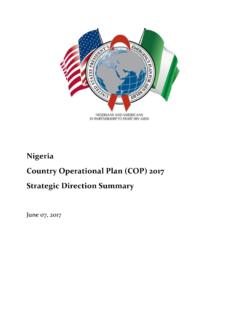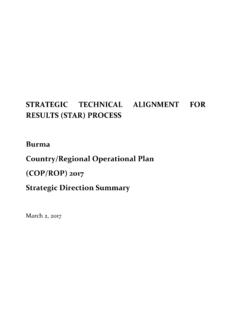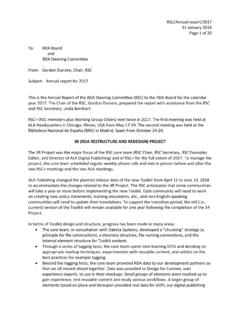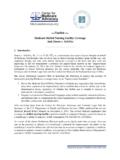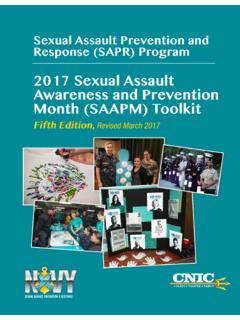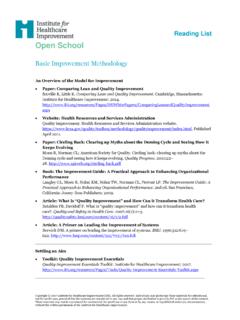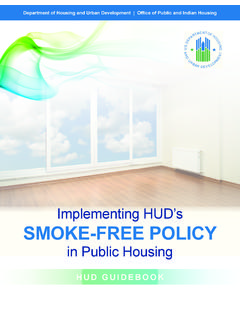Transcription of ZIMBABWE Country Operational Plan COP 2017 …
1 ZIMBABWE Country Operational Plan COP 2017 Strategic Direction Summary 2 | P a g e Table of Contents Goal Statement Epidemic, Response, and Program Context Summary statistics, disease burden and epidemic profile Investment profile Sustainability Profile Alignment of PEPFAR investments geographically to burden of disease Stakeholder engagement Geographic and population prioritization Program Activities for Epidemic Control in Scale-up Locations and Populations Targets for scale-up locations and populations Priority population prevention Voluntary medical male circumcision (VMMC) Preventing mother-to-child transmission (PMTCT) HIV testing and counseling (HTS) Facility and community-based care and support TB/HIV Adult treatment Pediatric Treatment OVC Addressing COP17 Technical Considerations Commodities Collaboration, Integration and Monitoring Program Activities for Epidemic Control in Attained and Sustained Locations and Populations (Note.)
2 In COP 2017 , ZIMBABWE does not have attained or sustained SNUs) Program Support Necessary to Achieve Sustained Epidemic Control Critical systems investments for achieving key programmatic gaps Critical systems investments for achieving priority policies Proposed system investments outside of programmatic gaps and priority policies USG Management, Operations and Staffing Plan to Achieve Stated Goals Appendix A Prioritization Appendix B- Budget Profile and Resource Projections Appendix C- Tables and Systems Investments for Section Appendix D- Summary of PEPFAR Funding to Local Organizations 3 | P a g e Acronym List ACT Accelerating Children's HIV/AIDS Treatment Initiative AE Adverse Event AGYW Adolescent Girls and Young Women ANC Antenatal Clinic ART Antiretroviral Treatment ARVs Antiretroviral BMGF Bill and Melinda Gates Foundation CARGS Community ART Refill Groups CATS Community Adolescent Treatment Support groups CBO Community Based Organization CCM Country Coordinating Mechanism CCW Community Case Workers CDC Centers for Disease Control and Prevention CESHHAR Centre for Sexual Health.
3 HIV and AIDS research CHW Community Health Workers CLHIV Children Living with HIV COP Country Operational Plan CrAg Cryptococcal Antigen CRFs Client Referral Facilitators CSE Continuing Secondary Education CSO Civil Society Organizations CTX Cotrimoxazole DBS Dried Blood Spot DfID United Kingdom s Department for International Development DHIS2 District Health Information System DMPPT2 VMMC Decision Makers Program Planning Toolkit DoS Department of State DREAMS Determined, Resilient, AIDS-free, Mentored, and Safe DSD Direct Service Delivery EA Expenditure Analysis ECD Early Childhood Development ECS Early Childhood Stimulation EID Early Infant Diagnosis EIMC Early Infant Male Circumcision EMR Electronic Medical Record System eMTCT Elimination of Mother to Child Transmission FBO Faith-Based Organization FM Families Matter FP Family Planning FSW Female Sex Workers 4 | P a g e GALZ Gay and Lesbian Association of ZIMBABWE GBV Gender Based Violence GEM Girls Empowerment Clubs GFATM Global Fund to Fight AIDS.
4 Tuberculosis and Malaria GoZ Government of ZIMBABWE HCW Health Care Workers HDP Health Development Partners HEI HIV Exposed Infant HIV HIV Human Immunodeficiency Virus HIVST HIV Self-Testing HMIS Health Management Information System HQ Headquarters HR Human Resources HRH Human Resources for Health HRIS Human Resource Information System HSS Health Systems Strengthening HTC HIV Testing and Counseling HTS HIV Testing Services ICF Intensified Case Finding INH Isoniazid IP Implementing Partner IPC Inter-personal Communication IPT Isoniazid Preventive Therapy KP Key Population LCI Local Capacity Initiative LGBTI Lesbian, Gay, Bi-Sexual, Transgendered or Intersex LMIS Logistics Management and Information Systems LPV/r Lopinavir/ritonavir LTFU Lost to Follow-Up M&E Monitoring and Evaluation MC Male Circumcision MCH Maternal and Child Health MMS Multi-Month Scripting MOHCC Ministry of Health and Child Care MOLSW Ministry of Labor and Social Welfare MOPSE Ministry of Primary and Secondary Education MSF Medecins Sans Frontiers MSM Men who have Sex with Men NAC National AIDS Council NATF National AIDS Trust Fund OI Opportunistic Infections OVC Orphans and Vulnerable Children 5 | P a g e PBAC PEPFAR Budget Allocation Calculator PEPFAR The President s Emergency Plan for AIDS Relief PITC Provider-initiated Testing and Counseling PLHIV People Living with HIV PMTCT Prevention of mother-to-child Transmission PMTCT Prevention of Mother to Child Transmission PNC Postnatal Care POART PEPFAR Oversight and Accountability Response POC Point
5 Of Care PrEP Pre-Exposure Prophylaxis QA/QI Quality Assurance/Quality Improvement RDS Respondent Driven Surveys RTK Rapid Test Kit SCMS Supply Chain Management System SDS Strategic Direction Summary SI Strategic Information SID Sustainability Index and Dashboard SIMS Site Improvement through Monitoring System SNU Sub National Unit STI Sexually Transmitted Infections SW Sex Workers TA Technical Assistance TAG Technical Advisory Committee TAT Turn Around Time TB Tuberculosis TBBAT Target Based Budgeting Allocation Tool TBD To Be Determined TBIC Tuberculosis Infection Control TLE Tenofovir Lamivudine Efavirenz TPT TB Preventive Therapy TTCV Tetanus Toxoid Containing Vaccines UE Unit Expenditure UNAIDS UNAIDS Joint United Nations Program on HIV/AIDS UNICEF United Nations Children s Fund USAID Agency for International Development USG Government VACS Violence against Children Survey VCT Voluntary Counseling and Testing VHWs Village Healthcare Workers VL Viral Load VMMC Voluntary Medical Male circumcision WHO World Health Organization YAZ Young Adult Survey of ZIMBABWE 6 | P a g e YWSS Young Women Selling Sex ZDHS ZIMBABWE Demographic Health Survey ZIMPHIA ZIMBABWE Population-Based Health Impact Assessment 7 | P a g e Goal Statement The PEPFAR interagency team, working collaboratively with key partners including the Government of ZIMBABWE (GoZ), the Global Fund to Fight AIDS, Tuberculosis and Malaria (GF), civil society core advocacy members, bilateral and multilateral health development partners, have contributed to the development of the Country Operational Plan for FY 2018 (COP 2017 ).
6 It builds on the current roll-out of Treat All (Test and Start) to rapidly increase national antiretroviral (ART) coverage and accelerate progress towards sustained epidemic control. The national ART program and other critical HIV programs in ZIMBABWE are implemented under the leadership of the Ministry of Health and Child Care (MOHCC), the Ministry of Primary and Secondary Education (MOPSE), and the Ministry of Labor and Social Welfare (MOLSW), with human resources (HRH) and infrastructure primarily funded by the MOHCC. PEPFAR has successfully leveraged this capacity with key commodities, training, mentoring, some HRH for HIV testing and treatment, and other site-level support. This has resulted in the successful scale up to an estimated 76% national ART coverage by early 2016. Building on the geographic prioritization developed in COP 2015, and further refined in COP 2016, the PEPFAR program will support the Ministry of Health and Child Care (MOHCC) to reach at least 90% treatment coverage in 36 districts, and 80% treatment coverage in four newly added PEPFAR districts by the end of FY 2018.
7 The PEPFAR program will invest in the delivery of a comprehensive package of HIV care, treatment, and prevention activities within 40 of ZIMBABWE s 60 districts and will transition away from a tiered site support approach which previously excluded PEPFAR support at clinics with fewer than 260 ART patients. This new approach will ensure that quality services are delivered at smaller, fast growing sites in a context of rapid decentralization. Utilizing new Joint United Nations Program on HIV/AIDS (UNAIDS) Spectrum estimates, which incorporate 2016 ZIMBABWE Population-Based Health Impact Assessment (ZIMPHIA) and ZIMBABWE Demographic Health Survey (ZDHS) population survey results, the PEPFAR program has developed district specific strategies targeting hard to reach priority populations to close the coverage gaps identified with the new data. An improved PEPFAR- ZIMBABWE HIV Testing and Counseling (HTC) strategy will enable the program to reach the first 90 by identifying new HIV-positives through activities such as index testing (contact tracing), and innovative interventions such as HIV self-testing, in order to better reach more men and young adults.
8 In addition to targeted high-impact prevention activities, PEPFAR will increase its voluntary medical male circumcision (VMMC) target from 252,847 to 306,139, focusing its efforts on reaching young men ages 15-29, with the help of additional central funds provided this year. The second 90 will be achieved in 40 PEPFAR Saturation districts through Treat All (expected to reach full implementation by April 2017 , which includes differentiated models of care such as mobile ART and same-day ART-initiation). PEPFAR will also increase its procurement of antiretroviral drugs (ARVs) from 192,989 to 215,000 patients, and support patient access to viral load testing which will reach 92% national coverage by December 2017 in order to measure progress towards the third 90. Support to Community Adolescent Treatment Support groups (CATS) and Community ART Refill Groups (CARGS) will also continue in COP 2017 . Through increased funding for COP 2017 , the PEPFAR program will scale up the Determined Resilient Empowered AIDS-Free Mentored and Safe (DREAMS) program by increasing the package of services in six districts where DREAMS is already operating (including the expansion 8 | P a g e of Pre-Exposure Prophylaxis (PrEP), and complementary activities supported within the orphans and vulnerable children (OVC) portfolio, by linking beneficiaries to HIV clinical services and concentrating on household economic strengthening.)
9 Moreover, clinical services targeting female sex workers (FSW) and men who have sex with men (MSM) will be scaled up significantly from the plan developed in COP 2016, and for the first time, will integrate key pops services into public health facilities. In COP 2016, PEPFAR expanded and introduced a number of new direct-service delivery (DSD) differentiated models of care to increase access and quality of services received both at the facility and community level based on feedback from civil society organizations and the MOHCC. Total funding for DSD activities excluding (DREAMS, VMMC and OVC proprogramming) was $10,422,068. In COP 2017 , over $20M has been programmed to expand existing DSD activities including HIV Self-Testing, human resources for health at public facilities for testing and antiretroviral (ART) initiation, PreP, CATS, CARGS and defaulter tracing. Moreover, PEPFAR ZIMBABWE will also introduce new DSD activity focused an adolescent friendly mental health services through the pilot Friendship Bench, to increase adherence, retention and address psychosocial challenges experienced by adolescents.
10 PEPFAR ZIMBABWE is committed to attaining the 90-90-90 goals outlined by UNAIDS and continues to use quarterly PEPFAR Oversight and Accountability Response Team (POART) reviews and the Site Improvement through Monitoring System (SIMS) findings to assess performance and further sharpen strategies and approaches to most efficiently deliver expected results. Furthermore, PEPFAR is and will continue to work closely with the Global Fund s Country Coordinating Mechanism (CCM) to ensure alignment of programming during the Global Fund s next funding cycle (2018-2020). Epidemic, Response, and Program Context Summary statistics, disease burden and Country profile According to the 2012 census, the projected 2015 population of ZIMBABWE was million. In 2016, ZIMBABWE completed the ZIMBABWE Population-Based HIV Impact Assessment (ZIMPHIA), a household-based national survey that measured the national HIV incidence, prevalence and viral load suppression.
